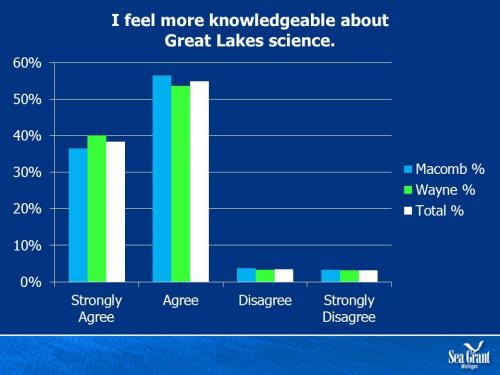Great Lakes Education Program fosters love of science, students report
Student evaluations of the 2014 Great Lakes Education Program show students loving science.

The 2014 Great Lakes Education Program (GLEP)– the program’s 24th – was notable for many reasons. It welcomed program participant No. 100,000 aboard, reached a number of new school districts in southeast Michigan, and conducted a new evaluation looking at student attitudes toward science. The student evaluation used a set of post-participation questions provided by Michigan State University Extension’s 4-H Youth Development office.
The Great Lakes Education Program provides classroom, vessel-based and shoreside education focusing on the biological, chemical, physical and cultural aspects of the Great Lakes. The vessel-based and shoreside education takes place along the shores of Lake St. Clair and the lower Detroit River. Named a National 4-H Program of Distinction and a past winner of the MSU Extension John Hannah Award for Program Excellence, GLEP has engaged more than 3,000 teachers, 12,000 adult chaperones, and 84,800 students since 1991 – all of whom learned about and became better stewards of the Great Lakes.
More than 1,500 student evaluations were analyzed for the 2014 GLEP year, representing both Lake St. Clair and the lower Detroit River. Approximately 85 percent of the students were 9 to 10 years of age, reflecting the program’s primary program focus on grades 4 and 5, and there were nearly the same number of male and female students surveyed. GLEP targets underserved populations, and the 2014 student survey reflected this. Of students from Macomb County, 35 percent were from underserved populations, while in Wayne County it was 42 percent.
In responding to specific evaluation questions, 93 percent of students agreed or strongly agreed with the statement “I feel more knowledgeable about Great Lake science” as a result of their GLEP experience. Eighty-eight percent agreed or strongly agreed with the statement “I like science” and 83 percent agreed or strongly agreed with the statement “I am good at science” following participation.
These self-reflections about science are gratifying but not surprising given the fact that teachers are consistent in their use of the GLEP curriculum provided as part of new-teacher training. And even less surprising since more than 70 percent seek additional Great Lakes information for use in their classroom during the year, whether through additional lessons such as Teaching Great Lakes Science from Michigan Sea Grant, or the Fresh & Salt curriculum developed by COSEE Great Lakes (now the Center for Great Lakes Literacy).
Teachers who are interested in developing a love of science – particularly as it relates to the Great Lakes – are encouraged to learn more about how they and their classes can participate in the Great Lakes Education Program. Visit the GLEP website at www.glep.us. Don’t miss the boat!




 Print
Print Email
Email


